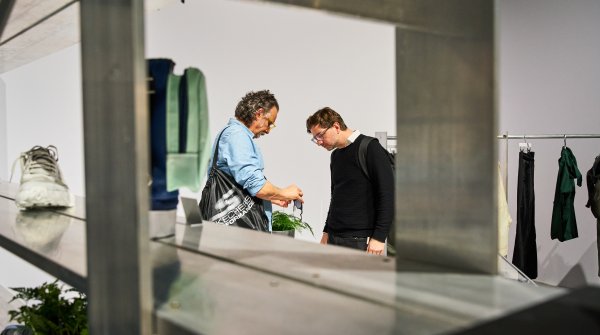"We need more customer engagement in the store and more hands-on support for sales staff. That's why we need digitization at the POS." What Jan Kegelberg means by this in his presentation at the ISPO Digitize Summit is not equipping the POS with digital gimmicks, but on the contrary: At SportScheck, digital tools help in the sales conversation between customers and sales staff.
The idea is obvious: with a tablet in hand, sales staff in the stores get real-time access to the inventory in the house, in the warehouse and in other stores, to detailed product information, to customer data and many other services. The salesperson no longer has to disappear into the warehouse to look for products and leave the customer alone. He does not have to send him to a permanently installed terminal. He does not have to let him go unsatisfied because the desired size is not in the house.
He can devote his attention entirely to the customer and his wishes.
This measure brought SportScheck stores more sales worth ten million euros last year. "The customer buys more, firstly because he feels well advised and secondly because we can still sell him products that are not in stock in the store," Kegelberg concludes.
The retailer has even been able to generate more customer data thanks to the tablets: the creation of new loyalty cards is much faster with the tablets and in personal conversations. Since the change management measures, around 130,000 new loyalty cards have been created and 90,000 customer records updated.
ISPO Digitize: Der zweite Tag in Bildern
But as obvious as it sounds, it was difficult to implement. At SportScheck, the introduction of iPads on the floor is just the visible part of a comprehensive digitization strategy for the entire infrastructure that the company has been working on for several years. And as is so often the case, not everything works right away.
The first investments in digital equipment for the stationary stores with kiosk terminals and web store tablets for customers and sales staff were made as early as 2011. But instead of enthusiasm, SportScheck mainly reaped disinterest back then.
Kegelberg: "It quickly became clear that the web store solution was not suitable for either the sales staff or the customers. The salesperson was missing important functions and it was cumbersome. It signaled to the customer: 'Nice that you came - but now see how you get along. And: 'Actually, you could have stayed at home on the sofa and ordered.' That was, of course, psychologically the completely wrong message!"
SportScheck therefore invested in the development of its own in-store app, which was implemented by CaperWhite. It has been used in the stores since 2015.
But programming a good app alone is not enough. You also have to find ways to make its advantages palatable to the sales staff. Says Kegelberg, "We put the tablets on the floors and waited to see what happened: Nothing happened."
Traditional training has also failed to deliver the expected results. In order to achieve a change in working methods and build new skills, targeted investments had to be made in change management processes and incentives created for staff.
Sales via the in-store app, for example, must also go to the seller's account, not the web store. "Otherwise, the seller has little interest in selling via the app," says Kegelberg. Playful ideas have also proven successful, he said, such as a sales battle between stores.
Today, sales staff scan the barcodes of products about 150 times a day to retrieve content. About 300 orders a day are generated via the in-store app, "with return rates only half as high as in the online store," says the digital chief.
In the hands of sales staff, he says, the in-store app has become a powerful tool. That's why the company is now ready to take the next steps. For example, more and more services are being added to the app: from ski rentals in the vacation region to booking yoga classes at affiliated studios to the payment function. SportScheck plans to introduce this function before the end of the year and is already building service stations in the stores where shopping bags and receipts can be picked up.
The introduction of the in-store app was a long and "painful" process, says Jan Kegelberg, but strategically necessary. "Even though we haven't yet developed a complete picture of everything else we can do with the app, and what services we can still integrate, we've laid the groundwork for the future." In the long term, this service will make it possible to sell more products and new types of assortments as well, without having to grow the real store space.
About 150 times a day, sales employees scan product barcodes to retrieve content. Approximately 300 orders are generated per day via the in-store app, “with only half as high return rates as in the online shop,” says the digital exec.
In the hands of the sales staff, the in-store app has become a powerful tool. That’s why they are now ready to take the next steps. More and more services are being added to the app: from ski rental in the holiday regions to booking yoga courses at affiliated studios, to the payment function. SportScheck aims to introduce that feature this year, and is already building service stations in the shops where shopping bags and receipts can be collected.
The introduction of the in-store app was lengthy and also “painful,” Jan Kegelberg says, but strategically necessary. “Even if we haven’t developed a complete picture of what we can still do with the app and which services we can still integrate, we have created the conditions for the future.” In the long term, this service will make it possible to sell more products and a new type of product range, without having to increase actual store space.

 Sports BusinessSki Mountaineering Goes Olympic: What Milano-Cortina 2026 Means
Sports BusinessSki Mountaineering Goes Olympic: What Milano-Cortina 2026 Means
- ISPO awards
- Mountain sports
- Bike
- Design
- Retail
- Fitness
- Health
- ISPO Job Market
- ISPO Munich
- ISPO Shanghai
- Running
- Brands
- Sustainability
- Olympia
- OutDoor
- Promotion
- Sports Business
- ISPO Textrends
- Triathlon
- Water sports
- Winter sports
- eSports
- SportsTech
- OutDoor by ISPO
- Heroes
- Transformation
- Sport Fashion
- Urban Culture
- Challenges of a CEO
- Trade fairs
- Sports
- Find the Balance
- Product reviews
- Newsletter Exclusive Area
- Magazine
























